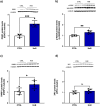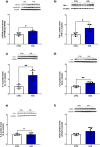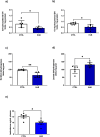Heat-not-burn technology affects plasma testosterone levels and markers of inflammation, oxidative stress in the testes of rats
- PMID: 39902465
- PMCID: PMC11788375
- DOI: 10.3389/ftox.2024.1515850
Heat-not-burn technology affects plasma testosterone levels and markers of inflammation, oxidative stress in the testes of rats
Abstract
Introduction: Heating tobacco products (HTPs) are advanced electronic cigarette models. Classified by the FDA as a modified-risk tobacco product and can be used as part of efforts to quit smoking. Using heat-not-burn (HnB) technology, these devices heat tobacco avoiding complete combustion. Although the levels of toxicants in the mainstream are significantly lower than those observed in tobacco smoke, some recent studies have raised concerns about potential health risks associated with their use, particularly regarding their effects on male gonadal function, which remain largely unexplored.
Methods: Adult male Sprague-Dawley rats were exposed, whole body, 5 days/week for 4 weeks to HnB mainstream.
Results: The expression of the cell cycle regulators Bax/Bcl-2 ratio is not affected, along with no changes in p-38. On the other hand, an increase in oxidative stress markers, including those associated with DNA damage, was observed in exposed animals, along with the induction of NF-kB dependent pro-inflammatory mediators: TNF-α, IL-1β, IL-6 and COX-2. Furthermore, inactivation of key androgenic enzymes, such as 3β-hydroxysteroid dehydrogenase and 17β-hydroxysteroid dehydrogenase, together with decreased testosterone synthesis suggest a potential impairment of male gonadal function.
Discussion: The results indicate that animals exposed to HnB smoke show higher levels of oxidative stress markers, including those associated with DNA damage, as well as higher levels of pro-inflammatory cytokines. The impairment of some androgenic key enzymes and those related to the activity of seminiferous epithelium, together with the decrease in testosterone levels, suggest an impairment of gonadal function through the alteration of some cellular pathways typically associated with tobacco consumption.
Keywords: DNA damage; heat-not-burn; inflammation; oxidative stress; testis.
Copyright © 2025 Granata, Morosini, Valerii, Fagiolino, Sangiorgi, Ghini, Spisni, Vivarelli, Fairclough, Paolini and Canistro.
Conflict of interest statement
Author IF was employed by Gruppo CSA—S.p.A. The remaining authors declare that the research was conducted in the absence of any commercial or financial relationships that could be construed as a potential conflict of interest.
Figures








Similar articles
-
Effects of unburned tobacco smoke on inflammatory and oxidative mediators in the rat prefrontal cortex.Front Pharmacol. 2024 Jan 25;15:1328917. doi: 10.3389/fphar.2024.1328917. eCollection 2024. Front Pharmacol. 2024. PMID: 38333013 Free PMC article.
-
Unburned Tobacco Cigarette Smoke Alters Rat Ultrastructural Lung Airways and DNA.Nicotine Tob Res. 2021 Nov 5;23(12):2127-2134. doi: 10.1093/ntr/ntab108. Nicotine Tob Res. 2021. PMID: 34036368
-
Effects of Fetal Exposure to Heat-Not-Burn Tobacco on Testicular Function in Male Offspring.Biol Pharm Bull. 2020;43(11):1687-1692. doi: 10.1248/bpb.b20-00390. Biol Pharm Bull. 2020. PMID: 33132313
-
IQOS - a heat-not-burn (HnB) tobacco product - chemical composition and possible impact on oxidative stress and inflammatory response. A systematic review.Toxicol Mech Methods. 2020 Feb;30(2):81-87. doi: 10.1080/15376516.2019.1669245. Epub 2019 Oct 2. Toxicol Mech Methods. 2020. PMID: 31532297
-
Heat Not Burn Tobacco Product-A New Global Trend: Impact of Heat-Not-Burn Tobacco Products on Public Health, a Systematic Review.Int J Environ Res Public Health. 2020 Jan 8;17(2):409. doi: 10.3390/ijerph17020409. Int J Environ Res Public Health. 2020. PMID: 31936252 Free PMC article.
References
-
- Abdelzaher W. Y., Mostafa-Hedeab G., Sayed AboBakr Ali A. H., Fawzy M. A., Ahmed A. F., Bahaa El-Deen M. A., et al. (2022). Idebenone regulates sirt1/Nrf2/TNF-α pathway with inhibition of oxidative stress, inflammation, and apoptosis in testicular torsion/detorsion in juvenile rats. Hum. Exp. Toxicol. 42, 9603271221102515. 10.1177/09603271221102515 - DOI - PubMed
-
- Alboghobeish S., Mahdavinia M., Zeidooni L., Samimi A., Oroojan A. A., Alizadeh S., et al. (2019). Efficiency of naringin against reproductive toxicity and testicular damages induced by bisphenol A in rats. Iran. J. Basic Med. Sci. 22 (3), 315–523. 10.22038/ijbms.2019.29757.7184 - DOI - PMC - PubMed
LinkOut - more resources
Full Text Sources
Research Materials

